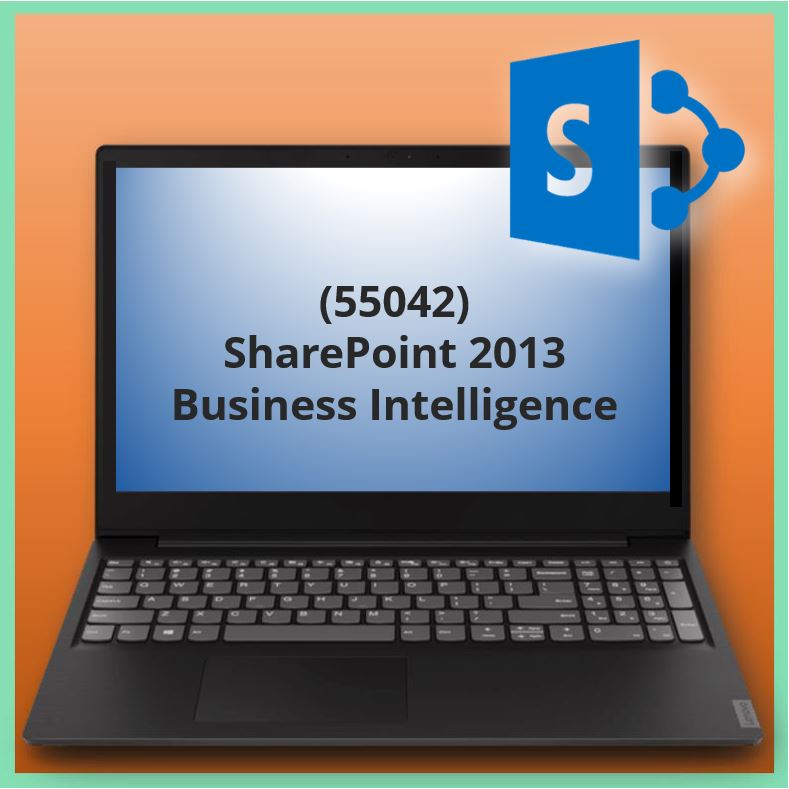Aangeboden leervormen

SharePoint 2013 Business Intelligence (55042)
Course Description
This course provides students with the necessary knowledge to work with all the associated SharePoint business intelligence services including PerformancePoint Service, Excel Services, Business Connectivity Services, and Visio Services. The new and improved Business Intelligence Center is explored, and all the exciting new features within the SharePoint 2013 release are covered.
The focus of this course is on the SharePoint 2013 business intelligence platform and not on the SQL business intelligence services.
At Course Completion
After completing this course, students will be able to:
• Browse the data within the cube using SQL Server Management Studio.
• Browse data using Visual Studio 2013.
• Connect to a tabular source, import tables, and explore the data.
• Explore the options and settings available within the new SharePoint 2013 Central Administration.
• Create a new web application and business intelligence site while exploring the features of both.
• Create a SharePoint library to hold Excel workbooks and explore trusted file locations.
• Utilize the Power View add-in for Excel.
• Create an Excel workbook with a parameter and save it to a SharePoint document library.
• Add Web Apps to a webpage.
• Explore the Dashboard Designer interface and know how to create and configure a data source.
• Create and configure a standard KPI and a scorecard.
• Create and configure a leaf KPI and a scorecard.
• Create two blank KPI’s and then roll them into an objective KPI.
• Create and configure an analytic chart and an analytic grid, add them to a dashboard, deploy them to SharePoint, and explore the options available.
• Create and configure a filter, and tie the filter into both the analytic chart and analytic grid created earlier.
• Create and configure a cascading filter and then tie it into a new analytic chart and grid.
• Create a Time Intelligence data connection, a Time Intelligence filter, and create a report using both.
• Create four copies of the Objective Scorecard, configure settings in each of the four copies, and deploy them to SharePoint in a dashboard.
• Create a new leaf KPI and use that KPI in two new scorecards, one with a filter configured, and one without.
• Create a new dashboard with two pages and review editing options.
• Create a drawing, upload the document to the Student BI Site documents library, and view the drawing in a browser.
• Create a data-connected drawing and upload the document to the Student BI Site documents library.
• Create an objective scorecard and matching strategy map, place them in a dashboard, and then upload the dashboard to the Student BI Site.
• Use PowerPivot within Excel to import a table from SQL Server.
• View the relationships existing within the imported tables from SQL Server and then import an additional table and configure a relationship between it and the existing.
• Hide columns they don’t want reflected in the resulting PivotTable.
• Create a PivotTable within an existing worksheet.
• Assign administrators and permissions on the BDC Metadata Store.
• Explore the different content types available in SharePoint 2013 and learn how to locate them and their corresponding settings.
• Create a document library, configure it to accept specific content types, and then learn how to delete the document library.
• Create and configure a new external content type.
• Create an external list associated with the new external content type created prior.
• Create a new external content type and a new host URL, and then create an external list and profile page.
• Add a custom action to an external list.
• Navigate the Report Builder 3.0 interface.
• Create an embedded data source connecting into a database.
• Create an embedded data source connecting into an OLAP database.
• Create a shared data source using the Report Manager.
• Create a shared dataset using the shared connection they created in the previous exercise.
• Create a new dashboard and explore three different ways to connect the Web Apps.

Voor wie
This course is intended for power users, business intelligence developers and IT professionals that will be involved with the design, development and maintenance of SharePoint 2013 business intelligence solutions.
Programma
Module 1: Course Overview
This module explains how the class will be structured and introduces course materials and additional administrative information.
Lessons
· Introduction
· Course Materials
· Facilities
· Prerequisites
· What We'll Be Discussing
After completing this module, students will be able to:
· Successfully log into their virtual machine.
· Have a full understanding of what the course intends to cover.
Module 2: The Business Intelligence Stack
In this module we will first look at the three different ways in which business intelligence can be viewed. Then, we’re going to look at the services SQL 2012 provides us and how they apply to business intelligence. We will then move to SharePoint 2013 and look at the SharePoint services to examine their relevance and how we can use them in business intelligence to surface data. In this section we will also cover the new business intelligence features available within the SharePoint 2013 release. Finally, we will take a brief look at PowerPivot, examining the new features and their significance. PowerPivot is covered in more detail in a later module.
Lessons
· Business Intelligence in Three Ways
· SQL 2012 Business Intelligence
· New 2013 SharePoint Business Intelligence Features
· New 2013 PowerPivot in Excel Features
Lab : The Business Intelligence Stack
· SQL 2012 Multidimensional Model Basics
· SQL 2012 Tabular Model Basics
After completing this module, students will be able to:
· Browse the data within the cube using SQL Server Management Studio.
· Browse data using Visual Studio 2013.
· Connect to a tabular source, import tables, and explore the data.
Module 3: SharePoint 2013 Business Intelligence Center
In this module, we will explore the new and improved 2013 SharePoint Central Administration site. We are going to cover specifically the new 2013 Business Intelligence Center template within SharePoint. We are also going to cover some things that generically apply to SharePoint that you can use within business intelligence. Permissions and Roles will be illuminated and the included Document Library and List apps will be explained.
Lessons
· New 2013 SharePoint Central Administration
· New 2013 Business Intelligence Center
· Permissions and Roles
· Included Document Library and List Apps
Lab : SharePoint 2013 Business Intelligence Center
· SharePoint 2013 Central Administration
· SharePoint 2013 Business Intelligence Center (Optional)
After completing this module, students will be able to:
· Explore the options and settings available within the new SharePoint 2013 Central Administration.
· Create a new web application and business intelligence site while exploring the features of both.
Module 4: SharePoint 2013 Excel Services
In this module, we will go over all the new 2013 Excel Services features, and we will explore the core components of Excel Services. We will cover Excel Web Access and it’s capabilities along with any differences you may encounter in the browser as opposed to the desktop client. There is coverage of the Power View add-in for Excel, and then lastly we will explain the save and share process and have a look at best practices.
Lessons
· New 2013 Excel Services Features
· Core Components
· Excel Web Access (EWA)
· What Excel Web Access is Not
· Differences in the Browser vs. Desktop
· SharePoint Libraries to Store Workbooks
· Power View Add-in for Excel
· The Save and Share Process
· Excel Web App
· Best Practices
Lab : SharePoint 2013 Excel Services
· Creating a Library to Hold Excel Workbooks
· Exploring the Power View Add-in for Excel
· Save and Share an Excel Workbook to a SharePoint Document Library
· Add an Excel Web App to a Webpage
After completing this module, students will be able to:
· Create a SharePoint library to hold Excel workbooks and explore trusted file locations.
· Utilize the Power View add-in for Excel
· Create an Excel workbook with a parameter and save it to a SharePoint document library.
· Add Web Apps to a webpage.
Module 5: SharePoint 2013 PerformancePoint 2013
In this module, we will give you an overview of the new 2013 PerformancePoint Services features. Dashboard Designer is explored along with many of the objects and connections available within.
Lessons
· New 2013 Overview of PerformancePoint Services
· Dashboard Designer
· Data Sources
· Indicators
· KPIs
· Visual Reports
· Filters
· Scorecards
· Dashboards
Lab : SharePoint 2013 PerformancePoint 2013
· PerformancePoint Services Dashboard Designer Introduction and Data Source Configuration
· Standard or Blank KPI Demonstration
· Leaf KPI Demonstration
· Objective KPI Demonstration
· Visual Reports
· PerformancePoint Filters
· PerformancePoint Cascading Filters
· Time Intelligence Filters
· Scorecard Settings
· Scorecards Filtered Using the Wizard
· PerformancePoint Dashboards
After completing this module, students will be able to:
• Explore the Dashboard Designer interface and know how to create and configure a data source.
• Create and configure a standard KPI and a scorecard.
• Create and configure a leaf KPI and a scorecard.
• Create two blank KPI’s and then roll them into an objective KPI.
• Create and configure an analytic chart and an analytic grid, add them to a dashboard, deploy them to SharePoint, and explore the options available.
• Create and configure a filter, and tie the filter into both the analytic chart and analytic grid created earlier.
• Create and configure a cascading filter and then tie it into a new analytic chart and grid.
• Create a Time Intelligence data connection, a Time Intelligence filter, and create a report using both.
• Create four copies of the Objective Scorecard, configure settings in each of the four copies, and deploy them to SharePoint in a dashboard.
• Create a new leaf KPI and use that KPI in two new scorecards, one with a filter configured, and one without.
• Create a new dashboard with two pages and review editing options.
Module 6: SharePoint 2013 Visio Services
Visio drawings can be extremely effective and in this module we cover the shared service that allows users to share and view them. We will go over all the new 2013 Visio Services features and also discuss data-connected drawings and how to configure them. There is also a section on viewing drawings within a browser.
Lessons
· New 2013 Visio Services Features
· Visio Graphics Service
· Visio Drawings in the Browser
· Visio Web Access Web Part
· Visio Drawings with Data Connections
Lab : SharePoint 2013 Visio Services
· Visio Drawing in the Browser
· Visio Services Data-Connected Drawing
· Dashboard Strategy Maps
After completing this module, students will be able to:
• Create a drawing, upload the document to the Student BI Site documents library, and view the drawing in a browser.
• Create a data-connected drawing and upload the document to the Student BI Site documents library.
• Create an objective scorecard and matching strategy map, place them in a dashboard, and then upload the dashboard to the Student BI Site.
Module 7: PowerPivot
PowerPivot is not a feature of SharePoint business intelligence, however, an Excel workbook with PowerPivot can be saved to a SharePoint site and then used in a business intelligence scenario. This module is intended as an overview of the product only and covers all the new features available in the 2013 release of the add-in.
Lessons
· New 2013 PowerPivot Features
· PowerPivot and Excel
· PowerPivot and SharePoint
· Enterprise Business Intelligence and PowerPivot
· Importing Data
· Enriching Data
· SharePoint Sharing
Lab : PowerPivot
· Import Data from SQL
· Review and Edit the Imported Relationships
· Hide Unused Columns
· Create a PivotTable
After completing this module, students will be able to:
• Use PowerPivot within Excel to import a table from SQL Server.
• View the relationships existing within the imported tables from SQL Server and then import an additional table and configure a relationship between it and the existing.
• Hide columns they don’t want reflected in the resulting PivotTable.
• Create a PivotTable within an existing worksheet.
Module 8: SharePoint 2013 Business Connectivity Services
In this module we will explore the new features available within SharePoint 2013 Business Connectivity Services, how to configure the security, and clarify the terminology.
Lessons
· New 2013 Business Connectivity Service Features
· What is Business Connectivity Services?
· BCS Terminology
· BCS Security
· Using SharePoint Designer 2013 with BCS
· Surfacing the BCS Data
Lab : SharePoint 2013 Business Connectivity Services
· SharePoint 2013 Business Connectivity Services
· Exploring Content Types in SharePoint
· Add a Document Library Tied to Content Types
· Creating an External Content Type
· Creating an External List
· Configuring the Business Connectivity Services for a Host URL & Setting up a Profile Page
· Add a Custom Action to a List
After completing this module, students will be able to:
• Assign administrators and permissions on the BDC Metadata Store.
• Explore the different content types available in SharePoint 2013 and learn how to locate them and their corresponding settings.
• Create a document library, configure it to accept specific content types, and then learn how to delete the document library.
• Create and configure a new external content type.
• Create an external list associated with the new external content type created prior.
• Create a new external content type and a new host URL, and then create an external list and profile page.
• Add a custom action to an external list.
Module 9: Dashboards
This module borrows from the three-day Microsoft course on Dashboards number 50596A. Monitoring, analyzing, and managing dashboards are discussed along with details on how to use them most effectively. This module does not cover Dashboard Designer as it is covered in more detail in the PerformancePoint Services module. Coverage of the Microsoft Report Builder 3.0 tool is brief as this course focuses on the SharePoint space.
Lessons
· Dashboard Migration
· Three Types of Dashboards
· Successful Dashboards
· Tables or Graphs
· Types of Graphs
· Choosing a Chart Type
· Key Performance Indicators
· Pitfalls In Dashboard Design
· Microsoft Report Builder 3.0
· Plan Your Reports
· Datasets
· New 2013 SharePoint Designer Features
· SharePoint Web Apps
Lab : Dashboards
· Explore the Report Builder 3.0 Interface (Optional)
· Create an Embedded Data Source into SQL 2012 Engine (Optional)
· Create an Embedded Data Source into SQL 2012 Analysis Services (Optional)
· Create a Shared Data Source Using the Report Manager (Optional)
· Create a Shared Dataset Using the Shared Data Source (Optional)
· Three Methods for Connecting Dashboard Web Apps
After completing this module, students will be able to:
· Navigate the Report Builder 3.0 interface.
· Create an embedded data source connecting into a database.
· Create an embedded data source connecting into an OLAP database.
· Create a shared data source using the Report Manager.
· Create a shared dataset using the shared connection they created in the previous exercise.
· Create a new dashboard and explore three different ways to connect the Web Apps.
Additional Reading
To help you prepare for this class, review the following resources:
· Brian Larson, Delivering Business Intelligence with Microsoft SQL Server 2012, Third Edition (McGraw-Hill Osborne Media, March 16, 2012)
Voorkennis
Before attending this course, students must have:
· An understanding of the benefits of business intelligence.
Examen
NVT
Duur training
Open Leercentrum: 3 dagen







